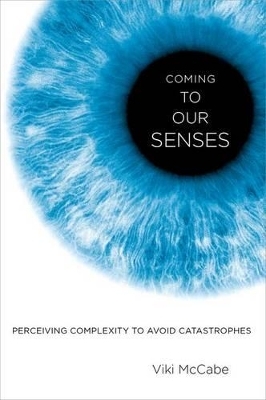
Coming to Our Senses
Oxford University Press Inc (Verlag)
978-0-19-998858-7 (ISBN)
In this intriguing, contrarian book, cognitive scientist Viki McCabe challenges entrenched beliefs about the roles of perception, cognition, and information in the decisions we make and the knowledge we acquire. Using cutting-edge research and compelling true stories, McCabe argues that the roots of our local and global problems lie in our reliance on the wrong information (theories), the wrong process (cognition), and the wrong worldview (atomism with its parts-perspective).
We have put the world at risk because we wrongly believe it to be an assembly of parts that we can manipulate at will. It is actually a coalition of self-organizing, complex systems--from cells to cities--that cannot be partitioned and retain their purpose. Nor is the information that specifies these systems packaged in our familiar verbal descriptions. Instead, such systems reveal themselves in fractal-like geometric configurations that emerge from each system's operations and reflect their structural organization. It is organization that brings each system into existence, produces its structure, and determines its functions. Thus, we come to know systems as disparate as neural networks, river deltas, trees, and economies by perceiving their branching structure. Without our conscious awareness, we can recognize other people by perceiving the unique version of a figure eight that oscillates around their belly buttons as they walk toward us. Form not only follows function; it doubles as information.
Nonetheless, our bossy brains continue to block our perceptions using illusions and ideologies decked out as theories that pave a path directly to our current conditions of ecological destruction, political paralysis, and economic failure. McCabe counsels us to put our theories aside and focus on our perceptions. If we give them priority status, the information they access can block the hostile mental takeovers that cause many of today's problems, reconnect us to reality, and bring us back to our senses.
Visiting Scholar, Department of Psychology, University of California, Los Angeles
INTRODUCTION ; PART 1: THE NATURE OF INFORMATION ; CHAPTER 1 THE STRUCTURE OF REALITY ; Theory overrides structure and promotes disaster: The Vincennes incident ; The Origins and Nature of Structural Information ; Saved by Structural Information ; Our Complex Perceptual Systems: J.J. Gibson's Views ; An Alternate View: Signal Detection Theory ; Complexity and Structural Information ; Seeing What We Believe: How the Mind Hijacks the Senses ; The Source of Common Sense: Our Senses ; CHAPTER 2 PERCEIVING STRUCTURE ; Recognition and Structural Information ; Altering Facial Proportions Alters Structure and Disrupts Recognition ; Care-giving by Configuration ; Facial Structure ; Face Blindness and Super-Recognizers ; What's Wrong with Eyewitness Testimony: Features vs. Structure ; Why Features Fail as Evidence ; Our Atomistic Worldview Leads Us Astray ; CHAPTER 3 STRUCTURE AND DYNAMICS ; Catching a Child Molester ; Dynamic Spatial Information ; Oscillating Figure Eight Reveals Identity ; Do We Have Memories of Structural Information? ; Our Brain-World Interface ; Navigation Grids and Space Cells ; Walking in Other People's Moccasins ; Reciprocating Structures: Experiencing Empathy ; CHAPTER 4 RESTRUCTURING REALITY ; Clouded Vision: No-Outlet Levees Destroy Delta Ecosystem ; Controlling Nature: Eliminating Natural Structure-Tributaries and Meanders ; The Whole is More Than the Sum of its Parts ; Restoring a Meander ; Structural Pattern Generators and Natural Structures ; Branching ; Spirals ; Meanders ; Hexagons ; CHAPTER 5 REALITY'S GEOMETRY ; The Good Friday Alaska Earthquake: The Real World Reinstates Itself ; Bacteria's Quorum Sensing ; Immune Cells Communicate Using Structural Configurations ; Volatile Compounds Send Aromatic Messages ; Animal Environment Reciprocities ; Frogs ; Crows ; Geese ; Mating, Foraging, Escaping ; Migrating Through Space ; Human-Environmental Affordances ; Acquiring and Representing Structural Information ; Benoit Mandelbrot's Fractals ; Our Fractal Brain ; CHAPTER 6 EXPERTS' EXPERTS ; Repetitions without Repetition ; Minimally Essential Spatial Information ; Experts' Experts Rely on Structural Information ; Diagnosing Injuries: Reading the Dynamics of Movement Deviations ; Curing Pain in the Brain: How the Brain Can Restructure Reality ; Diagnosing cancer: Pathology and Structural Information ; Condensing the Structure of Reality: The Japanese Garden ; Reading the Seascape: Sea Gypsies Survive a Tsunami ; Translating the Structure of Reality into Words ; PART TWO: MANUFACTURED INFORMATION AND THE BIASED BRAIN ; CHAPTER 7 MIND OVER MATTER: Theories and Other Mental Fallout ; Flawed Theory Disfigures Cancer Patients ; Where do Theories Come from? ; Theories and the Brain ; Hijacking the Interpreter ; Unacknowledged Theories that Threaten our Survival ; How to Judge a Theory ; CHAPTER 8 ARE SCIENTIFIC THEORIES DIFFERENT? ; Trial by Theory: Galileo and the Holy Office of the Inquisition ; Alfred Wegener and the Theory of Continental Drift ; Barbara McClintock and the Theory of Jumping Genes ; How Science can Progress by Extending Our Eyes ; Theories and Complexity ; CHAPTER 9 ARE ECONOMIC THEORIES DIFFERENT? ; Proctor and Gamble and Gibson Greeting Cards v. Bankers Trust ; Replacing Reality: The Evolution of the Derivative ; Seeing the Structural Information that Specifies the Market ; The Sad Saga of Brooksley Born ; An Alternative Theory of the Economy ; CHAPTER 10 COMPLEXITY, COMPONENTS, AND MENTAL CONCEPTS ; Death by Financial Concept ; Viral Components and Complex Systems ; Agribusiness: Turning Sustainable Complexity into Unsustainable Simplicity ; A Sustainable Complex System: The Family Farm ; From Complexity to Simplicity: From Whole Grains to Empty Calories ; From Nutritional Simplicity To Obesity ; EPILOGUE: A Cautionary Tale
| Erscheint lt. Verlag | 12.6.2014 |
|---|---|
| Verlagsort | New York |
| Sprache | englisch |
| Maße | 236 x 163 mm |
| Gewicht | 522 g |
| Themenwelt | Geisteswissenschaften ► Psychologie ► Allgemeine Psychologie |
| Geisteswissenschaften ► Psychologie ► Verhaltenstherapie | |
| Medizin / Pharmazie ► Medizinische Fachgebiete ► Neurologie | |
| ISBN-10 | 0-19-998858-7 / 0199988587 |
| ISBN-13 | 978-0-19-998858-7 / 9780199988587 |
| Zustand | Neuware |
| Haben Sie eine Frage zum Produkt? |
aus dem Bereich


